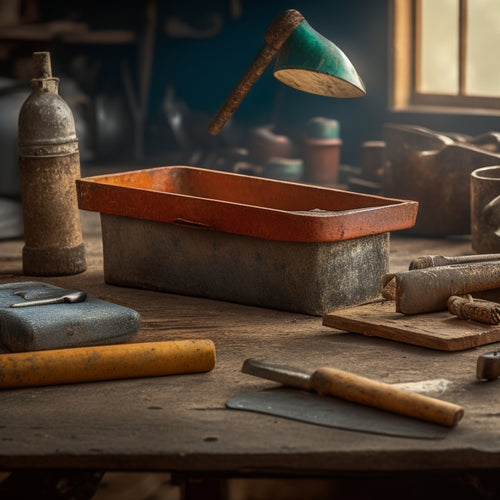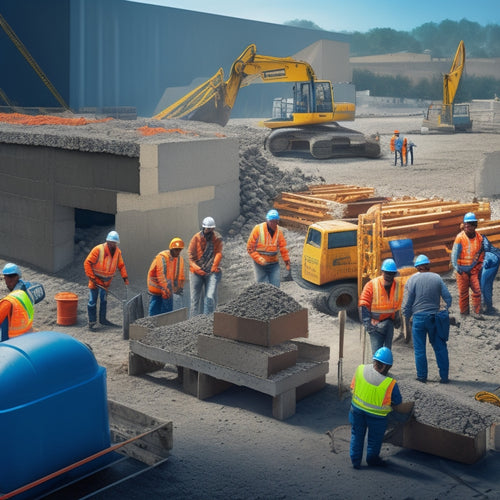
Why You Need These Tools for Concrete Construction
Share
You need an extensive range of specialized tools and techniques to achieve precise control, consistent quality, and maximum efficiency in concrete construction projects. From hand tools like levels and trowels to advanced equipment for tamping, leveling, and compaction, each tool plays a critical role in ensuring accurate block placement, smooth finishes, and strong bonds. With the right tools, you can optimize your workflow, reduce waste, and guarantee structural integrity. By leveraging these essential tools and techniques, you'll be well on your way to delivering high-quality concrete construction projects that meet exacting specifications and exceed client expectations - and there's more to explore on how to maximize their impact.
Key Takeaways
• Ensuring accuracy and precision in concrete construction requires the right tools to achieve professional results and meet project specifications.
• High-quality tools help minimize errors, reduce waste, and increase productivity, resulting in cost savings and efficient project timelines.
• Using the correct tools for each task ensures a strong bond between blocks and mortar, guaranteeing structural integrity and durability.
• The right tools enable workers to maintain a safe working environment, reducing the risk of accidents and injuries on the job site.
• Investing in essential tools for concrete construction is crucial for producing high-quality results, enhancing reputation, and building a successful business.
Essential Hand Tools for Block Work
You'll need a set of essential hand tools to efficiently lay and finish concrete blocks, including a level, trowel, and jointer. These tools will help you achieve a professional-looking finish and guarantee that your blocks are properly aligned.
When it comes to block layout strategies, a level is vital for confirming that your blocks are perfectly horizontal and vertical. A trowel is necessary for applying and spreading mortar, while a jointer helps to fill gaps between blocks.
Proper tool maintenance is also important to guarantee that your tools last longer and perform effectively. Regularly clean your tools after use, and store them in a dry place to prevent rust.
For your level, make sure to check its accuracy regularly and adjust it as needed. Additionally, keep your trowel's blade well-lubricated to prevent it from rusting.
Tamping and Leveling Made Easy
When you're working on a concrete construction project, you need to make certain that the surface is smooth, even, and accurately graded.
To achieve this, you'll want to focus on tamping and leveling, and the right tools can make all the difference.
With the right equipment, you can guarantee a smooth finish, maintain accurate grade control, and optimize the compaction process.
Smooth Finish Guaranteed
Your concrete surfaces demand precision, and that's exactly what you get with the right tamping and leveling tools, guaranteeing a smooth finish.
When it comes to tamping, you need a tool that can effectively compact and level the concrete, removing any air pockets and excess water. This is where a high-quality tamper comes in, allowing you to achieve a smooth, even surface. By using the right tamper, you can ascertain that your concrete surface is perfectly level, which is essential for applying finishing materials.
For a flawless finish, you'll need to employ advanced smoothing techniques. This may involve using specialized tools, such as trowels or floats, to remove any imperfections and achieve a high-gloss finish.
Accurate Grade Control
Achieving accurate grade control is essential in concrete construction, as it guarantees that the finished surface meets the desired specifications and tolerances. You need to verify that the concrete slab is laid at the correct elevation and pitch to prevent water accumulation, unevenness, and other issues that can compromise the structure's integrity.
To accomplish this, you'll require advanced grade measurement techniques and elevation assessment tools. These tools enable you to take precise measurements of the grade, identify deviations, and make necessary adjustments.
With the right tools, you can accurately assess the elevation of the concrete slab, detect any irregularities, and correct them promptly. This verifies that the finished surface is even, smooth, and meets the required specifications.
Efficient Compaction Process
After verifying the concrete slab's elevation and pitch, you can proceed to compact the surface to eliminate air pockets and confirm a uniform density, which is vital for achieving the desired strength and durability.
This is where efficient compaction techniques come into play. You'll need to employ the right tools to make certain that the concrete is compacted to the required specifications.
Using a plate compactor or a roller compactor, you can apply the necessary force to remove air pockets and achieve the desired density. It's important to follow the manufacturer's guidelines for compaction techniques to avoid over- or under-compaction, which can lead to weakened concrete.
Additionally, soil stabilization is an important aspect of the compaction process. You'll need to make sure that the soil beneath the concrete is stable and compacted to prevent settling or shifting, which can cause cracks and damage to the concrete.
Cutting and Breaking Blocks Efficiently
As you work with concrete blocks, you'll need to cut and break them efficiently to achieve precise fits and reduce waste.
To do this, you'll want to master precise block cutting methods that minimize chipping and cracking, as well as efficient breaking techniques that conserve energy.
Precise Block Cutting Methods
You can use various precise block cutting methods to assure accurate and efficient cutting and breaking of blocks, which is crucial for achieving professional-looking results in concrete construction projects.
When it comes to cutting blocks, you'll want to employ advanced cutting tools and techniques that assure precise cuts and minimize waste.
One popular block cutting technique is the use of a diamond blade saw, which utilizes a rotating blade embedded with diamond particles to make clean, accurate cuts.
Another effective method is the use of a masonry saw, which is specifically designed for cutting through concrete blocks and pavers.
These advanced cutting tools allow you to make precise cuts with ease, reducing the risk of errors and assuring that your blocks fit together seamlessly.
Efficient Breaking Techniques Used
In addition to precise cutting methods, mastering efficient breaking techniques is essential for completing concrete construction projects on time and within budget, as excessive breaking can lead to wasted materials and labor.
When you're working with concrete, you need to break it down efficiently to avoid delays and cost overruns. This is where having the right tools and techniques comes in.
You'll want to use hydraulic tools, such as hydraulic breakers or concrete crackers, to apply controlled force to the concrete. These tools allow you to target specific areas and break the concrete cleanly, reducing waste and labor.
Here are some efficient breaking methods to contemplate:
-
Pattern breaking: Breaking the concrete in a specific pattern to minimize waste and labor.
-
Score and break: Scoring the concrete before breaking to reduce the force needed and prevent over-breaking.
-
Pneumatic breaking: Using pneumatic tools to break concrete quickly and efficiently.
- Hydraulic shearing: Using hydraulic shears to cut and break concrete with precision and control.
Reducing Physical Labor Strain
By employing ergonomic handling techniques and strategically selecting cutting and breaking tools, contractors can greatly reduce physical labor strain when working with concrete blocks. You can minimize the physical demands of concrete construction by investing in ergonomic equipment designed to reduce fatigue and discomfort.
For instance, using a block cutter with a comfortable grip and balanced weight distribution can alleviate strain on your back and shoulders. Additionally, labor-saving devices like hydraulic block splitters can considerably reduce the manual effort required to break concrete blocks.
When selecting cutting and breaking tools, consider the weight, balance, and ergonomics of each device. Look for tools with adjustable handles, cushioned grips, and shock-absorbing materials to reduce vibration and impact.
By choosing the right tools and techniques, you can reduce the physical toll of concrete construction and increase your productivity. By minimizing physical labor strain, you can work more efficiently, complete projects faster, and reduce the risk of injury.
With the right tools and techniques, you can take the strain out of concrete construction and focus on delivering high-quality results.
Mixing and Laying Mortar Like Pro
Six essential steps are involved in mixing and laying mortar like a pro, starting with selecting the right mortar type for the job. You need to choose a mortar that's suitable for the specific application, taking into account factors like compressive strength, bonding requirements, and environmental conditions.
Once you've got the right mortar, it's time to prepare the mixing area. Make certain the surface is clean, dry, and free from any contaminants. Next, measure out the correct proportions of cement, sand, and water, and mix them together in a clean bucket or mixer. Be careful not to overmix, as this can lead to a weak and brittle mortar.
Here are some key tips to keep in mind:
-
Use a mortar mixer or a drill with a mixing paddle to guarantee thorough mixing and a consistent texture.
-
Add water gradually, mixing well between each addition, to avoid a too-wet or too-dry mix.
-
Apply the mortar to the surface using a trowel or other suitable tool, holding it at a 45-degree angle to guarantee good coverage and adhesion.
- Use a level to confirm the mortar is applied evenly and at the correct angle.
Setting Blocks With Precision Control
You'll need to set blocks with precision control to verify a sturdy structure, building on the strong foundation established by properly mixing and laying mortar. This requires mastering block alignment techniques that guarantee accurate placement and secure fitting.
To achieve this, you'll need precision measurement tools, such as spirit levels, laser levels, and precision squares, to verify the block's position and orientation. These tools will help you detect even the slightest deviations from the planned layout, allowing you to make adjustments before the mortar sets.
By using these tools, you'll be able to maintain a consistent and accurate block alignment, which is critical for load-bearing walls, corners, and other structural elements. Additionally, precision measurement tools will enable you to identify and correct any errors early on, saving you time and resources in the long run.
With the right tools and techniques, you'll be able to set blocks with confidence, knowing that your structure will stand the test of time.
Finishing Touches for a Strong Bond
To guarantee a strong bond between the blocks and mortar, apply a layer of grout to the joints, pressing it firmly into place with a grout float. This confirms the blocks are securely held together, creating a solid foundation for your concrete structure.
Next, consider applying bonding agents to the surface of the blocks. These agents improve the adhesion between the blocks and mortar, resulting in a stronger bond. You can also use surface treatment methods, such as acid etching or sandblasting, to roughen the surface of the blocks and increase the bonding area.
Additionally, don't forget to:
-
Clean the joints thoroughly before applying grout to remove any debris or excess mortar
-
Use a level to confirm the blocks are properly aligned and the joints are even
-
Apply a layer of sealant to protect the grout from water and stains
- Follow the manufacturer's instructions for the specific bonding agents and surface treatments you're using
Frequently Asked Questions
Can I Use a Regular Drill for Mixing Mortar and Concrete?
You're wondering if you can use a regular drill for mixing mortar and concrete.
The short answer is no. Regular drills aren't designed for the high-torque, low-speed demands of mortar mixing.
You'll need a drill specifically designed for mixing, such as a paddle mixer or a drill with a mixing paddle attachment.
These drill types provide the necessary power and control to effectively mix mortar and concrete, ensuring a strong and durable finish.
How Do I Prevent Mortar From Drying Out Too Quickly?
When working with mortar, you'll want to avoid the frustrating phenomenon of 'rapid dehydration syndrome' - aka, mortar drying out too quickly!
To combat this, you'll employ mortar retention methods, such as regularly misting the mix, using a retarder, or incorporating a hydration-control additive.
Additionally, implement moisture control techniques like covering the mix or using a humidifier.
What Safety Gear Is Essential for Concrete Construction?
When working with concrete, you're exposed to hazardous materials and situations. You must prioritize your safety above all.
You'll need a hard hat to protect your head from falling debris or concrete chunks. Safety goggles are also essential to shield your eyes from cement dust, chemical splashes, and flying particles.
Don't forget gloves, steel-toed boots, and a dust mask to guarantee thorough protection. These essentials will help you avoid serious injuries and stay focused on the job.
Can I Lay Blocks in the Rain or During Freezing Weather?
You're about to attempt the impossible: laying blocks in a torrential downpour or freezing temps!
Let's get real, you're not a superhero, and concrete isn't magic.
Block laying in harsh weather conditions is a no-go.
Rain can wash away freshly laid mortar, while freezing temperatures can weaken the bond between blocks.
You'll end up with a structurally unsound mess.
Wait for fair weather, or risk compromising the integrity of your construction project.
How Long Does It Take for Mortar to Fully Set and Harden?
When you're working with mortar, you'll want to know how long it takes to fully set and harden. The mortar setting process typically takes around 24 to 48 hours, depending on environmental conditions.
During this time, it's essential to maintain the right temperature and humidity levels.
The curing process can take anywhere from a few days to several weeks, during which you should keep the mortar moist to guarantee peak strength and durability.
Conclusion
You've got the foundation laid, literally!
With these essential tools for concrete construction, you're well on your way to building a strong and sturdy structure.
Don't let your project crumble - remember, the devil is in the details.
By having the right tools for the job, you'll be able to 'hammer out' the competition and create a solid foundation that will stand the test of time.
Related Posts
-

Smart Guide to Buying Used Concrete Hand Tools
You're about to buy used concrete hand tools, and you need to get it right. Dedicate time to identify the tools you n...
-

Why These Tools Are Crucial for Concrete Patio
You're about to commence on a concrete patio project, and having the right tools is vital to achieving professional-l...
-

7 Best Tools for Concrete Block Construction
You'll need a solid foundation, precise cutting, and seamless finishing to guarantee your concrete block construction...


